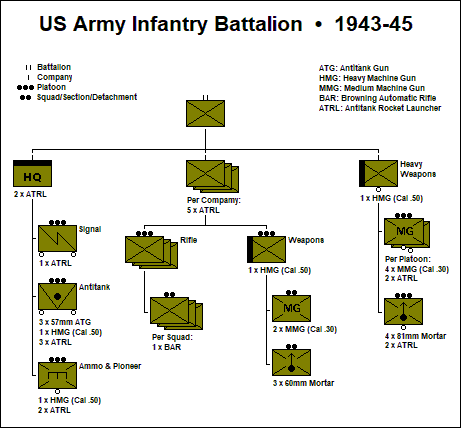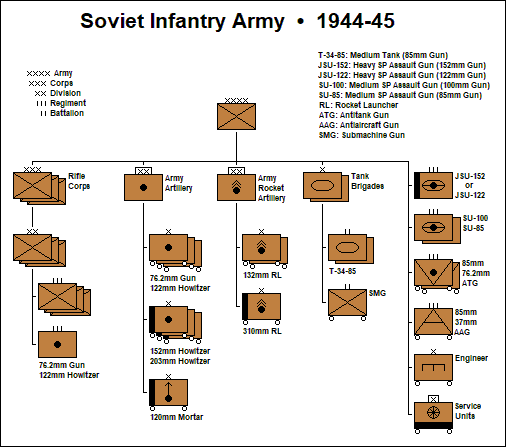● ● ●
The
study of the military history of World War II
requires an understanding of military organizations, so that
when reading of a “two-division attack,” its scale can be
envisioned. In modern times most armies worldwide have
employed broadly similar organizational templates. These are
defined below for WW II armies using 1944
US Army
tables of organization and equipment (TOE) as examples, and
are broadly applicable to the French British, Italian and
other 1939-45 European armies, with variations noted.
THE WESTERN ALLIED AND
AXIS ARMIES
Team:
4-6 troops. The 1944 US Army 60mm mortar team had 1 NCO and
4 EM (enlisted men)
Squad or Section: 12-15
troops. The 1944 US Army rifle squad had 1 NCO (sergeant) as
squad leader and 11 EM.
Platoon:
40-50 troops. The 1944 US Army rifle platoon had three rifle
squads plus a headquarters section for a total of 41 troops.
Commanded by a 2nd lieutenant.
Company (Troop in the Cavalry;
Battery in the Field
Artillery):
150-200 troops. The 1944 US Army rifle company had three
rifle platoons plus a weapons platoon (machine guns and
light mortars) and a headquarters section for a total of 195
troops. Commanded by a captain.
Battalion (Squadron in the Cavalry):
500-1000 troops. The 1944 US Army infantry battalion had
three rifle companies, a weapons company (machine guns and
medium mortars) and a headquarters company for a total of
871 troops. Commanded by a lieutenant colonel.

Organization of a 1943-44 US Army infantry
battalion using standard NATO military symbols
Regiment, Brigade or Group:
2,000-3,500 troops. The 1944
US Army infantry regiment
has three infantry battalions, an infantry cannon company,
an infantry antitank company and a regimental headquarters
company for a total of 3,118 troops. Commanded by a colonel.
Division:
10,000-15,000 troops. The division was the largest army
formation with a fixed organization. The
1944 US
infantry division had three infantry regiments,
four field artillery battalions, a mechanized cavalry
reconnaissance troop, a combat engineer battalion and a
division special troops battalion (supply, maintenance and
transportation) for a total of 14,352 troops. Commanded by a
major general (two stars). The
infantry divisions of the German Army
were not as standardized as those of the US and British
armies, since they were raised in waves (Wellen)
using the organizational template in force at the time.
Those of the Italian army were “binary,” with two instead of
three infantry regiments.
Armament of the 1944 US Army
Infantry Division
36 x 105mm howitzers
12 x 155mm howitzers
18 x 105mm infantry guns
27 x 57mm antitank guns
144 x light (60mm) and medium (81mm)
mortars
393 x machine guns (cal .30 and cal
.50)
557 x anti-tank rocket launchers
(bazookas)
90 x submachine guns
5,204 x carbines
6,761 x rifles
In 1944 most US Army infantry
divisions had an attached tank battalion with 57 medium
tanks and 17 light tanks, or an attached tank destroyer
battalion with 36 armored self-propelled antitank guns.
Corps:
2 to 4 divisions plus supporting units such as field
artillery, mechanized cavalry, etc. The composition of a
corps depended on its assigned mission. A typical US Army
corps was VII Corps in June 1944, which had 4 infantry
divisions plus field artillery, mechanized cavalry, tank
destroyer and a wide array of support units for the D-Day
invasion. Commanded by a major general or lieutenant general
(three stars).
Field Army:
2 to 5 corps plus supporting units as for a corps. Commanded
by a lieutenant general or a full general (4 stars).
Army Group:
2 to 5 field armies. Commanded by a full general.
THE RED ARMY
The above definitions also apply to
the Red Army, albeit with many reservations. During World
War II the Red Army indeed used such titles as battalion,
regiment, division, corps for its formations, but these
did not accurately reflect the size and organization of its
units. A 1944-45 medium tank battalion, for instance, had
scarcely more tanks that a US Army tank company: 21 x T-34
versus 18 x M4 Sherman. The cavalry division was actually
the size of a Western regiment or brigade. The
cavalry corps,
tank corps and
mechanized corps were
actually division-sized units. As for the Red Army’s
rifle (infantry) divisions,
they were intermediate in size between a Western division
and brigade, with an authorized strength of around 9,400
men.
In the reorganization following the
German invasion, the rifle corps were abolished altogether,
their divisions coming under the direct command of the field
army headquarters. When the corps began to be reintroduced
in mid-1943 they had little in the way of non-divisional
combat support units, these being held at
army or front
(army group) level.

Organization of a 1944-4 Soviet infantry
army using standard NATO military symbols
By 1944, The Red Army's major units—field armies and
fronts—were approaching the size of their Western and German
counterparts. The diagram depicts a typical infantry army of
the period. It should be remembered, however, that the
army's sub-units were generally smaller than those of other
armies, even when they were at full strength, which usually
they were not. In 1941-42 a front tended to be a third to
half the size of a German army group; only in late 1944 was
something like parity achieved.
ACTUAL VERSUS AUTHORIZED
STRENGTH
In WW II,
once units entered combat they began suffering casualties
and quickly fell below their authorized strengths. This was
particularly true of the infantry, which bore the brunt of
combat and had the highest casualty rate. All armies had
replacement systems but especially during periods of intense
combat the flow of replacements was insufficient to cover
casualties. A rifle company with an authorized strength of
195 troops might therefore muster only 100, 75 or 50 after a
few days of combat. After a few months of combat a rifle
platoon or rifle company might have suffered 100% turnover,
meaning that its original troops had all been killed,
wounded, captured or incapacitated by sickness.
All
armies had difficulty replacing their losses, particularly
in the infantry. Red Army rifle divisions, for example, were
chronically understrength, often with as little as 50% of
their authorized manpower. The German Army had similar
problems, particularly from 1942 to 1945, as its manpower
crisis progressively worsened. The US and British armies
also faced shortages of infantry replacements, particularly
in 1944-45, but their powerful armored, artillery and air
forces did much to make up for this deficiency.
An
excellent source of information on the military
organizations of all countries during WW II is Dr.
Leo Niehorster’s website,
World War II Armed Forces: Orders of
Battle and Organizations.
● ● ●
Copyright © 2020 by Thomas M.
Gregg. All Rights Reserved

BACK to WAR ROOM
Front Page